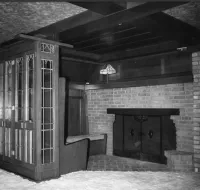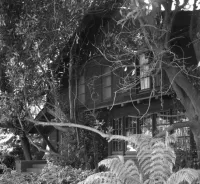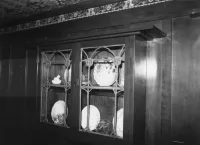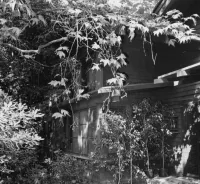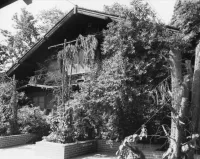Share what you know,
and discover more.
Share what you know,
and discover more.
Jun 21, 1984
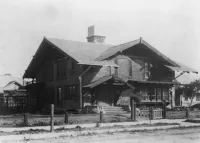
-

- Charmaine Bantugan
Jennie A. Reeve House (Reeve-Townsend House)- National Register of Historic Places
Statement of Significance The Reeve House is significant alone as an example of the work of American architects Greene and Greene, their work being now considered to have reached the highest level of the Arts and Crafts movement in America. It is more significant because it represents the pivotal design in the evolution and the development of the Greenes' progressive and articulated wood structural vocabulary. The Reeve House was their first design to bring together the varied elements, explored individually in designs of the previous two years, and which were to so dominantly influence American house design for several decades. Here was represented the use of simple materials, attention to expressed wooden structure, dominant and functional roof forms, highly articulated joinery, concerns for health, light, and air circulation, total control of the design of house, furniture, lighting fixtures, leaded and stained-glass windows, hardware, landscaping, etc. The Reeve House opened the door and established the Greenes' direction for their works which would bring dignity and quality to residential design regardless of size. Even the most modest of bungalows could now possess ""style"". Following the Reeve House, it was a matter of refinement of principles developed here. In 1902 and 1903, the various elements contributing to the Greenes' evolution as craftsman architects appeared only as parts of one structure or another. But in January of 1904, the design for the Jennie A, Reeve House in Long Beach, California brought the full range of their new architectural vocabulary together for the first time. Here in this simple two-story, shingle-clad bungalow was the articulated timber structure, multiple-gabled overhanging roofs with projecting support beams now shaped on the ends, open sleeping porches, vertical slit windows, horizontal bands of casement windows, the sensitive combination of cobblestone with brick masonry; special door, leaded glass and lantern designs; the coordination of landscape, walks, fencing, and garden gates, and a full development of interior furniture and accessories. The Greenes responded to the corner oceanfront site and the chilly, sometimes foggy environment with a carefully composed and compact plan which paid special attention to the seaside climate. Three massive fireplaces formed the axial core of the plan, and the living room and a flexible bedroom on the ground floor (often used as a related family room) were oriented to the ocean view and featured great bands of glass window walls and window seats to catch the rays of sunshine and brighten the detail of the interior wood paneling. In contrast, the corner inglenook of the living room provided a cave-like quality and was an invitation into a smaller, protected space with corner seating built into a hearth of the grand firebox. Imaginative attention was paid to every aspect of the house. On the beautifully crafted interior, the Greenes' imprint was easily recognized in the carefully detailed paneling and built-in cabinetwork where the expressed pegs were softly rounded and the finish of the wood had a waxed patina. Leaded glass designs coordinated the panes of doors and windows with the China cabinets and interior storage units. The furniture, too, was designed for the house and styled very much after Gustav Stickley pieces. Such totality of design and craftsmanship establishes the Reeve House as one of the most significant of the Greenes' works. Here was craftsmanship and design quality anticipating the masterpieces of 1907-09.
Jennie A. Reeve House (Reeve-Townsend House)- National Register of Historic Places
Statement of Significance The Reeve House is significant alone as an example of the work of American architects Greene and Greene, their work being now considered to have reached the highest level of the Arts and Crafts movement in America. It is more significant because it represents the pivotal design in the evolution and the development of the Greenes' progressive and articulated wood structural vocabulary. The Reeve House was their first design to bring together the varied elements, explored individually in designs of the previous two years, and which were to so dominantly influence American house design for several decades. Here was represented the use of simple materials, attention to expressed wooden structure, dominant and functional roof forms, highly articulated joinery, concerns for health, light, and air circulation, total control of the design of house, furniture, lighting fixtures, leaded and stained-glass windows, hardware, landscaping, etc. The Reeve House opened the door and established the Greenes' direction for their works which would bring dignity and quality to residential design regardless of size. Even the most modest of bungalows could now possess ""style"". Following the Reeve House, it was a matter of refinement of principles developed here. In 1902 and 1903, the various elements contributing to the Greenes' evolution as craftsman architects appeared only as parts of one structure or another. But in January of 1904, the design for the Jennie A, Reeve House in Long Beach, California brought the full range of their new architectural vocabulary together for the first time. Here in this simple two-story, shingle-clad bungalow was the articulated timber structure, multiple-gabled overhanging roofs with projecting support beams now shaped on the ends, open sleeping porches, vertical slit windows, horizontal bands of casement windows, the sensitive combination of cobblestone with brick masonry; special door, leaded glass and lantern designs; the coordination of landscape, walks, fencing, and garden gates, and a full development of interior furniture and accessories. The Greenes responded to the corner oceanfront site and the chilly, sometimes foggy environment with a carefully composed and compact plan which paid special attention to the seaside climate. Three massive fireplaces formed the axial core of the plan, and the living room and a flexible bedroom on the ground floor (often used as a related family room) were oriented to the ocean view and featured great bands of glass window walls and window seats to catch the rays of sunshine and brighten the detail of the interior wood paneling. In contrast, the corner inglenook of the living room provided a cave-like quality and was an invitation into a smaller, protected space with corner seating built into a hearth of the grand firebox. Imaginative attention was paid to every aspect of the house. On the beautifully crafted interior, the Greenes' imprint was easily recognized in the carefully detailed paneling and built-in cabinetwork where the expressed pegs were softly rounded and the finish of the wood had a waxed patina. Leaded glass designs coordinated the panes of doors and windows with the China cabinets and interior storage units. The furniture, too, was designed for the house and styled very much after Gustav Stickley pieces. Such totality of design and craftsmanship establishes the Reeve House as one of the most significant of the Greenes' works. Here was craftsmanship and design quality anticipating the masterpieces of 1907-09.
Jun 21, 1984
Jennie A. Reeve House (Reeve-Townsend House)- National Register of Historic Places
Statement of SignificanceThe Reeve House is significant alone as an example of the work of American architects Greene and Greene, their work being now considered to have reached the highest level of the Arts and Crafts movement in America. It is more significant because it represents the pivotal design in the evolution and the development of the Greenes' progressive and articulated wood structural vocabulary. The Reeve House was their first design to bring together the varied elements, explored individually in designs of the previous two years, and which were to so dominantly influence American house design for several decades. Here was represented the use of simple materials, attention to expressed wooden structure, dominant and functional roof forms, highly articulated joinery, concerns for health, light, and air circulation, total control of the design of house, furniture, lighting fixtures, leaded and stained-glass windows, hardware, landscaping, etc. The Reeve House opened the door and established the Greenes' direction for their works which would bring dignity and quality to residential design regardless of size. Even the most modest of bungalows could now possess ""style"". Following the Reeve House, it was a matter of refinement of principles developed here.
In 1902 and 1903, the various elements contributing to the Greenes' evolution as craftsman architects appeared only as parts of one structure or another. But in January of 1904, the design for the Jennie A, Reeve House in Long Beach, California brought the full range of their new architectural vocabulary together for the first time. Here in this simple two-story, shingle-clad bungalow was the articulated timber structure, multiple-gabled overhanging roofs with projecting support beams now shaped on the ends, open sleeping porches, vertical slit windows, horizontal bands of casement windows, the sensitive combination of cobblestone with brick masonry; special door, leaded glass and lantern designs; the coordination of landscape, walks, fencing, and garden gates, and a full development of interior furniture and accessories. The Greenes responded to the corner oceanfront site and the chilly, sometimes foggy environment with a carefully composed and compact plan which paid special attention to the seaside climate. Three massive fireplaces formed the axial core of the plan, and the living room and a flexible bedroom on the ground floor (often used as a related family room) were oriented to the ocean view and featured great bands of glass window walls and window seats to catch the rays of sunshine and brighten the detail of the interior wood paneling. In contrast, the corner inglenook of the living room provided a cave-like quality and was an invitation into a smaller, protected space with corner seating built into a hearth of the grand firebox. Imaginative attention was paid to every aspect of the house. On the beautifully crafted interior, the Greenes' imprint was easily recognized in the carefully detailed paneling and built-in cabinetwork where the expressed pegs were softly rounded and the finish of the wood had a waxed patina. Leaded glass designs coordinated the panes of doors and windows with the China cabinets and interior storage units. The furniture, too, was designed for the house and styled very much after Gustav Stickley pieces. Such totality of design and craftsmanship establishes the Reeve House as one of the most significant of the Greenes' works. Here was craftsmanship and design quality anticipating the masterpieces of 1907-09.
Posted Date
Mar 22, 2022
Historical Record Date
Jun 21, 1984
Source Name
United States Department of Interior - National Park Service
Source Website
Delete Story
Are you sure you want to delete this story?


